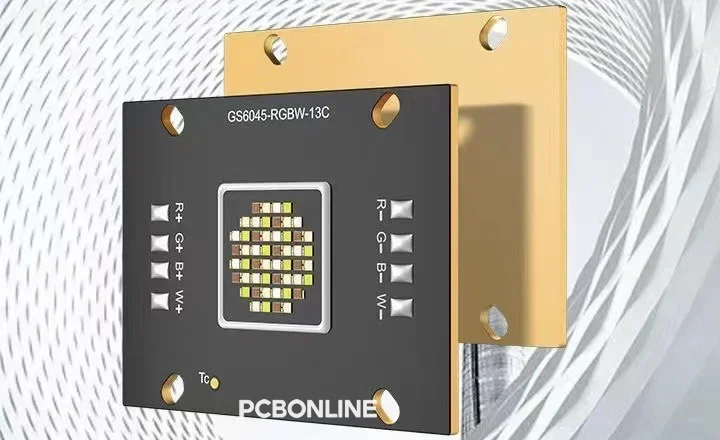
Industrial controls, automotive engines, and renewable energy power storage and generation systems all require high-power circuits with high thermal conductivity. Custom high-power PCBs (printed circuit PCBs) in various types come in as the foundation of high-power applications. A high-power PCB one-stop manufacturer, PCBONLINE, shares four strategies for developing high-power PCBs:
High-Power PCB Overview
A high-power PCB (Printed Circuit PCB) can flow through large electrical currents and effectively dissipate heat from components like FPGA, BGA, LED, and so on. Unlike regular FR4 PCBs that manage small to medium currents of a few amps, high-power PCBs deal with currents from tens to hundreds of amps or even more.
High-power PCBs can be single-layer, double-layer, multilayer, ceramic, copper-based, FR4, aluminum, using metal enclosure, using thermal vias, using copper busbars, using heat sinks and cooling fan, and with large trace width/space. The high-power supporting strategy is custom, as long as the design proves to work and can dissipate heat effectively.
High-power PCBs often feature —
- Superior thermal management
- Thick copper circuit layers
- Materials with high thermal conductivity
- Heat sinks and a cooling fan
- Large trace width and spacing
- Large area of copper
- Through-hole electronic components
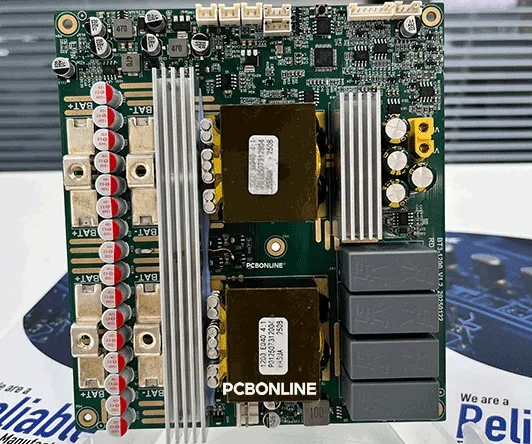
Common applications of high-power PCBs include:
- Lithium-ion battery management systems, cell connection systems, motor controllers, charging piles, and rail traction systems.
- Power supplies, motor drives, robotics, welding equipment, and factory automation.
- Solar inverters, wind turbine control systems, and home energy storage.
- High-power LED streetlights, building exterior lights, stage lights, automotive front lights, and industrial illumination.
- DC-DC converters, AC-DC power supplies, uninterruptible power supplies (UPS), and industrial transformers.
- Photovoltaic battery modules, industrial robots, radar systems, and laser generators.
PCBONLINE has 20 years of high-power PCB manufacturing experience for the above applications. In the following content, we will focus on the four high-power strategies for PCBs.
Using Thick Copper Circuit Layers for High-Current PCBs
PCB copper thickness is measured in ounces (oz) per square foot. For applications demanding a large current to flow, their PCBs are often designed to be heavy-copper. Heavy-copper PCBs' copper thickness is 3oz and above. The thick-copper PCB manufacturer PCBONLINE can fabricate PCBs with copper up to 14oz.
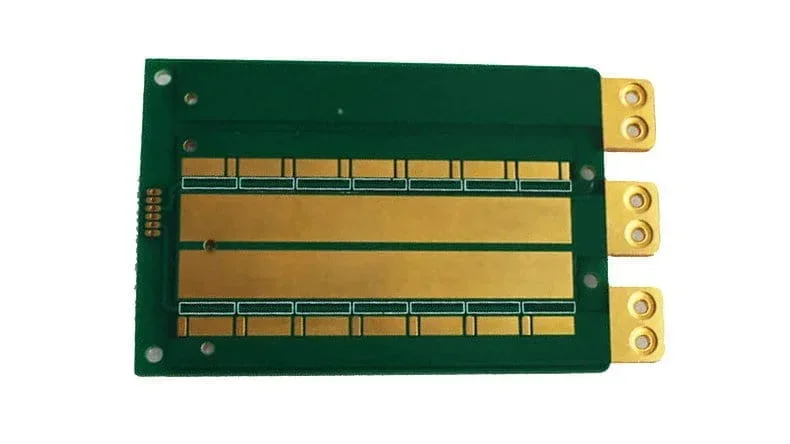
For high-power PCBs, an increased copper thickness directly enhances the current-carrying capability. For a PCB that can withstand a given maximum current, a larger copper thickness reduces resistance, so it generates less heat.
Excessive heat can lead to performance degradation, component damage, and PCB failure. By increasing the copper thickness, the PCB can carry more current and get rid of excessive thermal.
The greater volume of copper improves the reliability in a high-power PCB design.
At PCBONLINE, heavy-copper PCB manufacturing involves specialized processes. For copper thicknesses under 10oz, internal layers are generated by standard etching, while external layers undergo electroplating to achieve the desired thickness. For PCBs 10oz and above, we laminate red copper foil with prepreg.
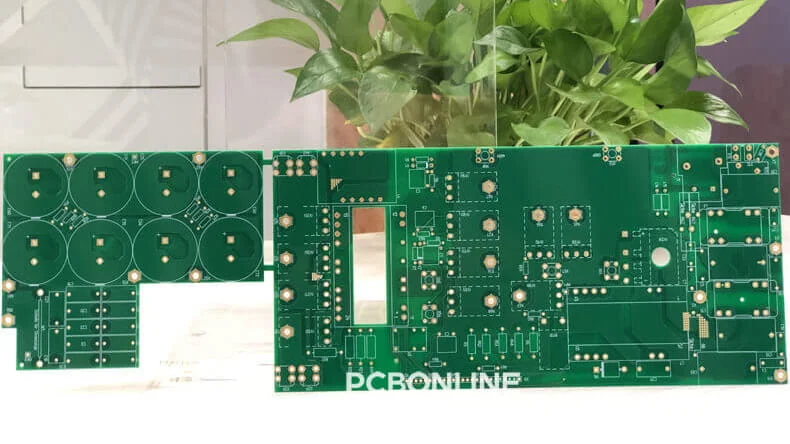
During heavy copper PCB fabrication, PCBONLINE applies solder mask by electrostatic spraying. This is because traditional silkscreen printing can result in uneven ink thickness. Electrostatic spraying ensures a uniform solder mask on the thick-copper PCB.
In heavy-copper PCB assembly, we carefully control reflow soldering temperatures. Due to the greater copper volume and excellent heat dissipation, thick-copper PCBs require higher temperatures, typically ranging from 290°C to 300°C.
The inherent mechanical strength of thicker copper enhances PCB durability. PCBONLINE offers custom manufacturing and assembly for copper thicknesses from 3oz to 14oz, certified with ISO, IPC, IATF, RoHS, REACH, and UL. If you want high-power PCBs, we can deliver thick-copper PCBs for the most demanding high-current and high-voltage applications.
Thick copper manages large currents, mitigates thermal stress, and provides robust mechanical support. PCBONLINE provides thick-copper PCBs from 1 to 10 layers, with precise etching, and various surface finishes like HASL and ENIG, tailored for any high-power environments.
Embedding or Mounting Copper Busbars in the PCB
Besides increasing circuit layers' copper thickness, integrating busbars offers another powerful solution for high-current PCB design. A PCB busbar is a brass or copper metallic strip or bar directly on or within the printed circuit board. It offers superior electrical and thermal conductivity and robust mechanical support. In high-power PCB designs, using busbars is an efficient and reliable strategy.
In a high-power PCB, busbars serve as high-power distribution pathways. The large cross-sections of busbars can carry high currents and reduce heat generation. By channeling high currents through busbars, you can greatly reduce the thermal and electrical burden on PCB traces.
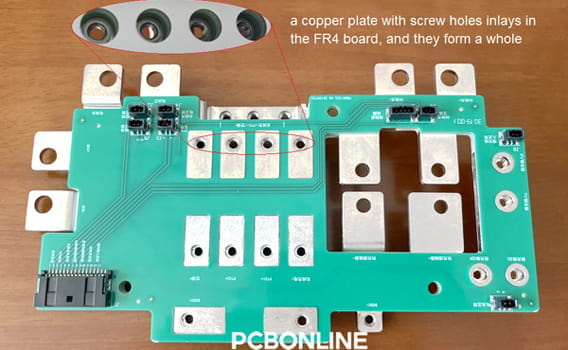
For example, this high-power charging pile conversion board is manufactured by PCBONLINE for fast-charging electronic vehicles. In designing this high-current PCB, PCBONLINE separates the large and small currents. PCBONLINE uses copper busbars for large current conduction and thermal dissipation, and the FR4 PCB area with a 3oz copper thickness for small currents and signal conduction.
There are several types of PCB busbars. Copper busbars are prevalent due to copper's exceptional conductivity. Aluminum busbars are a lighter and more cost-effective alternative to copper busbars. Flexible busbars provide versatility for complex geometries, while multi-layer busbars can accommodate higher current densities or integrate multiple voltage rails.
Busbars can be inlayed or surface-mounted within the PCB structure. Copper busbars are integrated into the PCB substrate, and high currents flow through them. Direct busbar integration enables high-power PCBs to safely handle currents exceeding 100A, often reducing the associated temperature rise by 20°C or more compared to designs relying only on conventional traces.
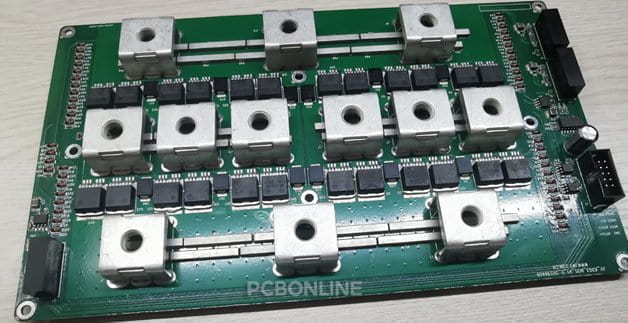
Wondering about the other advantages of incorporating busbars in a PCB? Busbars enhance the mechanical stability of the PCB in environments with vibration and physical stress. They also draw heat away from components, thereby preventing localized hotspots. Besides, busbars provide reliable mechanical connections, serving as robust attachment points for high-power PCBs.
However, busbar integration can impose layout constraints. It is vital to consider Electromagnetic Interference (EMI) and Electromagnetic Compatibility (EMC) to ensure busbars do not generate noise or interfere with sensitive circuits. You must plan the amount of copper used, the busbar's form and cross-section, and the overall thermal management strategy. PCBONLINE provides free DFM (design for manufacturing) and will help solve your PCB busbar design issues.
Using High Thermal-Conductivity PCB Materials — Ceramic PCB or Copper-Core PCB
While copper thickness and busbars conduct electricity and heat through metallic pathways, using high thermal conductivity material dissipates heat through the substrate. Standard FR-4 is not an ideal substrate material for high-power applications. High thermal-conductivity materials, such as copper, ceramics (aluminum nitride and aluminum oxide), and aluminum, are selected. Selecting the appropriate high thermal-conductivity material is important to ensure long-term reliability in high-power PCBs.
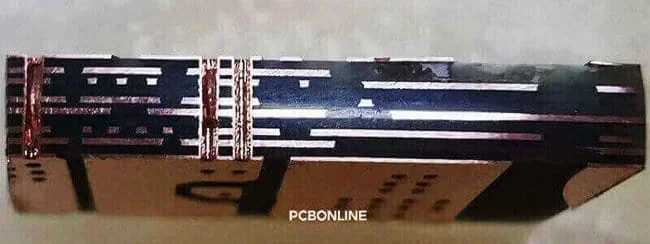
Copper-core PCB
Copper-base PCBs, also known as copper-core PCBs, use a copper plate as the substrate. Copper itself boasts an impressive thermal conductivity of 398 W/mK. While the dielectric layer in standard copper-base PCBs can impede some heat transfer, thermoelectric separation technology allows for direct heat transfer from components to the copper base.
Copper-core PCBs are effective for high-power LED lighting, electricity systems, and medical electronics, where efficient heat removal is paramount. PCBONLINE offers copper core PCBs with thermal conductivity up to 398W/mK.
We provide 1 to 8-layer copper core PCBs, including hybrid substrates combining copper with materials like ceramic, FR4, or Rogers. This exceptional thermal conductivity ensures that heat generated by high-power components is rapidly dissipated, consistently maintaining optimal operating temperatures.
Aluminum PCB
Aluminum PCBs employ an aluminum substrate. Their thermal conductivity typically ranges from 1 W/mK to 9 W/mK at PCBONLINE, though commonly found at 1 W/mK or 2 W/mK. Due to the lower cost of aluminum and simpler fabrication processes, aluminum PCBs are widely adopted in various LED lighting applications. While not as thermally conductive as direct copper-base solutions, they offer a large thermal performance improvement over FR-4 for moderate-power dissipation needs.
Ceramic PCB
Ceramic PCBs use ceramic materials like alumina or aluminum nitride as the substrate. They are used for the most thermally demanding high-power applications.
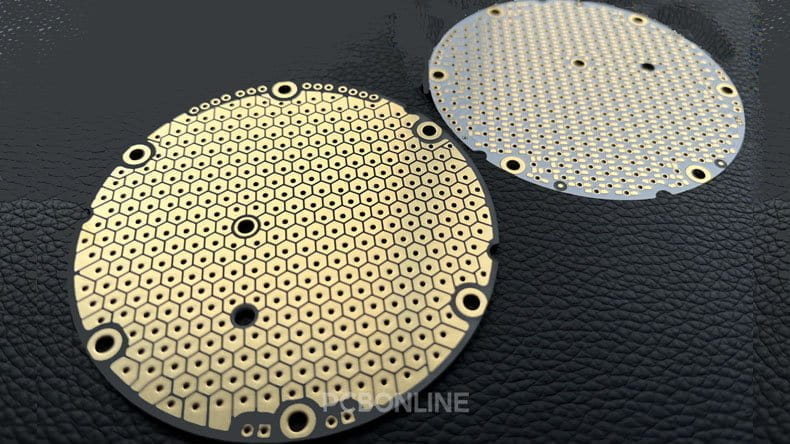
Alumina (Al2O3) PCBs offer approximately 20 W/mK thermal conductivity, while Aluminum Nitride (AlN) PCBs provide exceptional thermal conductivity, reaching up to 180 W/mK.
Ceramic PCBs are well-suited for high-power devices due to their stable mechanical and chemical properties, as well as a thermal expansion coefficient similar to that of semiconductors.
Ceramic PCBs are extensively used in high-power LED lighting, automotive sensors, and communication antennas—environments characterized by extreme heat and demanding conditions.
Ceramic PCBs are also ideal for direct chip-on-board due to their superior thermal match with semiconductor dies.
PCBONLINE fabricates AlN PCBs using 99.96% aluminum nitride, offers copper/AlN hybrid PCBs, and provides engineering support to prevent carbonization.
The selection among the PCB substrate materials depends on the power dissipation requirements, cost constraints, and environmental conditions of the application.
For instance, a 100A high-current PCB might combine 4oz copper thickness with heat sinks and a copper-base substrate to effectively manage the large thermal load.
PCBONLINE offers custom high-power PCB manufacturing and assembly services, including wire bonding and flip-chip technologies, alongside full component sourcing and value-added services.
Our extensive capability to manufacture a wide range of high thermal-conductivity PCBs ensures that your high-power designs achieve optimal thermal performance and long-term reliability.
Increasing Trace Width and Spacing
While PCB materials and structures like busbars enhance a PCB's power-handling capabilities, the fundamental design of increasing trace width and spacing remains critical.
The current capacity of a PCB trace defines the maximum current it can safely carry without overheating. Excessive heat can lead to trace degradation, delamination, or even catastrophic PCB failure.
For high-power devices such as battery management systems and industrial inverters, the currents can soar to 50A, 80A, 100A, or even 200A, far exceeding the typical 2A to 10A found in commercial electronics. Increasing the trace width is an absolute baseline for these high-power PCB designs.
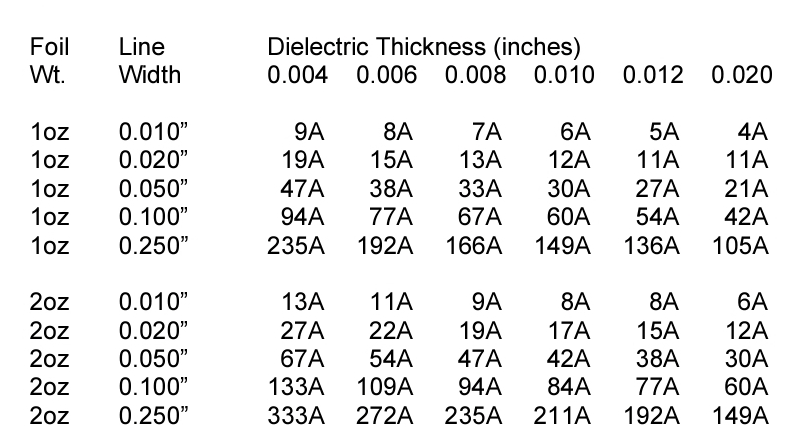
The relationship between current, trace width, and copper thickness is governed by fundamental physics and standardized by guidelines like IPC-2221. The theoretical current capacity (I) can be estimated using empirical formulas that consider trace width (W), copper thickness (H), and coefficients based on temperature rise and whether the trace is an external or internal layer.
For example, at a 10°C temperature rise, an external 1oz copper trace 0.5mm wide can handle approximately 3A. In contrast, a 4-oz copper trace of the same width could safely manage over 8A.
Higher current values consistently necessitate wider traces and/or thicker copper layers to maintain a safe temperature rise.
Designers commonly target a temperature rise, such as 10°C or 20°C above ambient, to ensure component reliability and PCB longevity. These precise calculations are fundamental for designing high-power PCBs that operate reliably under constant electrical stress.
Beyond the above methods, using terminal connectors is another strategy for high-power PCB design. Components like SMD nuts, PCB terminals, and copper sheets provide secure and low-resistance current
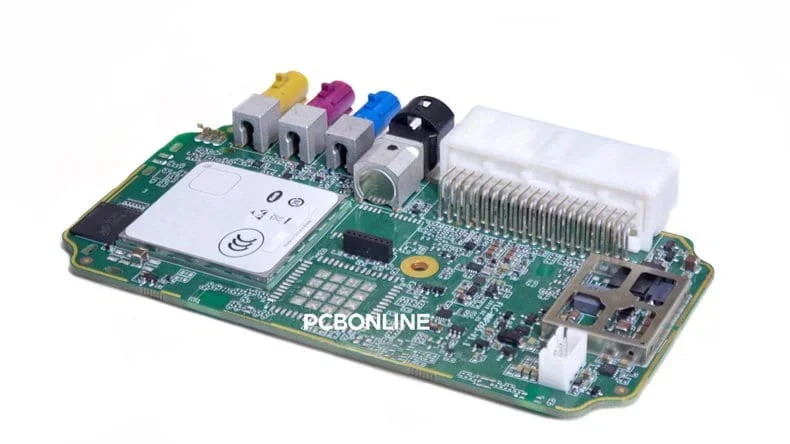
One-Stop High-Power PCB Manufacturer PCBONLINE
PCBONLINE is a trustworthy high-power PCB manufacturer, providing power and high-current PCB fabrication and high-quality solutions from the initial ideas to the end products.

Founded in 2005, PBONLINE has two large advanced PCB manufacturing bases and one PCB assembly factory. It is a privately owned company that is ISO-verified.
PCBONLINE can fabricate any type of high-power PCB, thick-copper, ceramic, copper-based, using busbars, or using terminal connectors.
PCBONLINE has rich R&D and fabrication experience in thermal management for high-power PCBs.
We offer high-power PCB manufacturing, component sourcing, PCB assembly, PCBA functional testing, conformal coating, IC burn-in, thermal aging testing, and box-build assembly.
PCBONLINE provides free DFM, DFT, DFA, and DFX and can optimize your high-power PCB design to reduce costs with quality sacrifice.
No matter what quantity of boards you want, we prioritize quality, certified with ISO 9001:2015, ISO 14001:2015, IATF 16949:2016, RoHS, REACH, UL, IPC-A-600 Class 2/3, and IPC-A-610 Class 2/3.
Over many years, PCBONLINE has served many high-power PCB projects, such as electric vehicle charging stations, CCS modules for lithium battery packs, air conditioning central systems, industrial transformers, etc.
If you need a high-quality and affordable busbar PCB, contact PCBONLINE by email at info@pcbonline.com.
Conclusion
To conclude, current distribution and thermal management are the primary issues for high-power PCB designs. Increasing copper thickness, using busbars, using high thermal-conductivity materials, and increasing trace width are four useful strategies for high-power PCBs. Working with PCBONLINE assures that your high-power PCBs are in the skilled hands of professionals and will yield successful results.
PCB Assembly from PCBONLINE.pdf
Battery Management System Manufacturing at PCBONLINE.pdf
CCS Product Introduction - PCBONLINE.pdf








